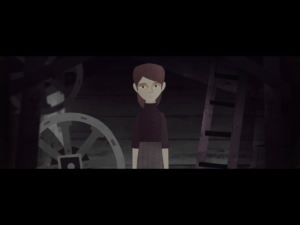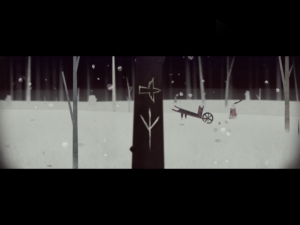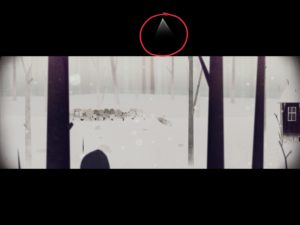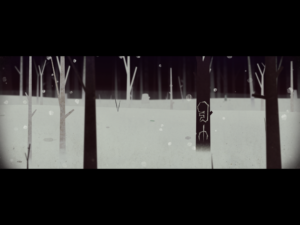Critical Play: Mysteries – Year Walk
Basic Information
Name of game: Year Walk
Creator (Developer): Simogo
Platform: Played on iPad for this Critical Play; also available on Windows and OS X PC and Wii U
Target Audience: Presumably pre-teens and older who are interested in Mystery, Adventure, and mild Thriller/Horror genres
How mechanics support and narratives are woven into the mystery of Year Walk
As described by Simogo Fandom, the overall narrative of Year Walk focuses on the story of Daniel Svensson, who lives in the made-up town of Vedtorp, Sweden in the late 1800s. Against the wishes of the girl he is in love with, Stina, Daniel partakes in a ‘Year Walk’ with the goal of being able to see the future. During his Year Walk, he interacts with many scary-looking, fantastical creatures whom he solves puzzles from. Once Daniel receives the key to his final destination from the creatures, it is finally revealed to him that Stina does not in fact love him, and that in the future he will be convicted and sentenced to death for murdering her.

This narrative is successfully woven into the mystery because the mystery seems to have many levels to it. The overall mystery in the game that the player is aiming to determine is what Daniel will see in his future, and whether he will meet a happy or tragic fate. The smaller mysteries scattered throughout the game ensue from the player’s interactions with the creepy-looking creatures, who are mysteries all on their own. The many layers of mystery surround the characters of the game and the fate of the protagonist interweave the narrative serving as the foundation of the game.
The mechanics of the game also support the mystery. The universe that the player is placed in is uncharted territory that the player must explore in tangent with unraveling the mystery of the narrative. As a result, the player’s ability to explore the environment somewhat freely aligns with the goal of uncovering the truth behind the situation. Additional mechanics of the game include the player’s ability to solve puzzles and complete small quests for the fantastical creatures by interacting with different specific objects in the game (such as picking things up or twisting or selecting them). By enabling the player to solve the puzzles necessary to get closer to cracking the mystery, the game’s mechanics thus also support the mystery.
Formal Elements of the Game
1.Players
Year Walk is a single-player game. In terms of interaction patterns, the game is set up to be Single Player vs Game. There are no other human players in this game pattern; instead, the singer player roams through the creepy, sinister environment from a first-person perspective while searching for clues to puzzles embedded within the game’s surroundings.
2. Objectives
The primary objectives of this game are Solution and Exploration.
The player must solve the puzzle/mystery that is the game itself, which is made up of a series of smaller puzzles that must be solved in order to progress with the game. In order to solve these smaller puzzles, the player must explore the game environment to pick up patterns and solutions to unlocking the next part of the game. Most of these clues and hints are non-obvious, and thus require the player to explore the game environment thoroughly and carefully.

3. Outcomes
Since there is no “game over” state to this game, there are really only two outcomes:
- The player solves the series of puzzles and completes the game, thus “winning” the game.
- The player is stuck at a puzzle and gives up, and is thus stuck in the game.
4. Procedures
The procedures of this game are fairly limited given that it’s designed to be played on a mobile device like an iPad and iPhone. The player is capable of moving forward, backward, leftward, and rightward by swiping on the screen.
Special actions include the occasions in which the user can interact directly with objects on the screen by tapping, dragging, and swiping, which often occurs when solving puzzles. There are even instances where the user must rotate or move their device to interact with an object.
5. Rules
The rules are inherently defined by the movements and actions allowed by the game at any given location and point in time. These inherent rules enable the player to progress further along the game’s set story line and plot. The overall “rule” guiding the progress of the game is that in order to progress further down the storyline and solve more puzzles, the player must devote energy to exploring the map and identifying the puzzles to solve as well as the corresponding solutions.
6. Resources
The resources that the player is allotted to achieve the objectives of the game – to solve puzzles and explore the environment in order to find the puzzles and their clues – are the player’s senses. Based on the sounds of feet stepping into terrain whenever the player moves, it can be inferred that the player has the resources to walk. The player is also able to sense their surroundings through auditory means (unsettling music and the correct sounds corresponding to objects being moved or ghosts appearing) provided by the game. The ability for the user to perceive their surroundings through a limited first-person perspective is also an important resource.

7. Boundaries
One of the most noticeable boundaries of this game pertains to the player’s line of vision; the player’s perspective is always “forward,” in that the player cannot rotate their perspective in order to look around more freely. Additionally, the digital universe is not open-world; the player is limited to moving forwards and backwards by the white arrows that appear on the top and bottom margins of the screen when a path is possible, and can only move left and right for a limited number of steps. In terms of boundaries related to interaction, not all objects in the game can be interacted with – only ones that play roles in solving puzzles or progressing with the plot of the storyline. Finally, the player is limited by the pace of their walk, and can neither speed up nor slow down. An additional notable boundary (or lack thereof) is the unlimited time the user can allot to figuring out the puzzles and exploring the digital world.

Aesthetic of Fun
The intended aesthetics of fun in this game are primarily Discovery and Narrative, with a hint of Fantasy, as the player is meant to solve the mystery behind the game while also exploring the fantastical, supernatural world hosting the story. The game was successful in meeting this goal through the design of its formal elements.
Namely, the interaction pattern of Player vs Game enables the player to immerse themselves fully into the narrative of the story and its environment without the distraction of other players competing to win. This is a significant and effective design decision for two reasons: 1) the process of Discovery is usually a very personal process and one that is done on one’s own pace, 2) allowing one to fully immerse themselves in a Fantasy world at a pace that is completely within one’s control enables them to fully absorb the Narrative. The lack of complex Procedures and Rules coupled with the clear Boundaries of the game (in terms of arrows pointing to where the player can move) creates a similar benefit for the player; the player does not have to memorize or focus on a complicated set of guidelines, and can instead allocate their attention to exploring and appreciating the fantastical narrative of the game.
The Exploration objective of the game (described in detail above) feeds right into its aesthetic of Discovery, while the Solution objective of the game (also described in detail above) contributes greatly to the game’s Narrative aesthetic. By stringing together the Narrative of the game through puzzles that the player must find a Solution for, these objectives arguably contribute the most to forming the aesthetics of fun to this game.

Further, the fact that the Outcomes of this game do not include a “game over” state and that the Boundaries do not include a time limit relieves pressure from the user to skip over any of the environment’s details for the sake of trying to “beat” another entity. Instead, it further encourages Discovery and slow and steady absorption and appreciation of the Narrative, as well as the details of the digital Fantasy world.
Finally, the Resources of this game in the form of the player’s senses of sight, hearing, and touch contributes greatly to the Fantasy aesthetic. The creepy sound effects and background music, the dark visual aesthetic, the creepy dolls and objects the player must interact with, and the occasional jump scare all pull the player into this scary make-believe world.
Moments of Particular Success or Epic Fails
One moment of particular success I encountered was solving the first major puzzle of twisting a doll’s head in order to get a secret code to open another entrance. Despite feeling a little creeped out by the fact that the doll’s head suddenly turned bloody, it was immensely satisfying to make this step and continue along with the intriguing narrative.

One moment of epic fail was when I was wandering around aimlessly and in circles in the snowy forest, trying but failing to determine where I could possible turn to next to continue with the story. At that point, I was really tempted to just quit the game due to my frustration, and had to consult an online walkthrough to figure out what to do next.
Suggested Improvements for the Game
To I wish that there had been some sort of in-game “guide” that I could have consulted in the game to give my hints on next steps to take. For example, in The Legend of Zelda video games, the protagonist is accompanied by a guiding figure that gives vague clues on next steps. I believe some of hint-giving figure in this game would have mitigated my frustration and the urge to call it quits.
Another improvement I would suggest for this game is updating the game so that the player can view their surroundings in a more 360 degree perspective. The fixed forward-looking perspective made the experience less realistic and more pre-programmed, which took away from the Discovery aesthetic of fun.



